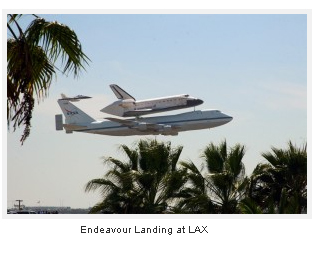As the space shuttle rides off into history, private initiatives, incentivized competitions and new technologies are transforming the race into space.
 By Dr. Peter H. Diamandis
By Dr. Peter H. Diamandis
Peter is the founder and chairman of the X PRIZE Foundation and the co-founder and chairman of Singularity University.
The final flight of the space shuttle Endeavour across the country, and then across California, strapped to the back of a Boeing 747, brought to a bittersweet end a notable era in space exploration in the United States, perhaps what should be thought of as the Third Era of Space Travel and Exploration.

I would say the Third Era because the First involved the decades of initial experimentation and unmanned rockets starting with Robert Goddard and then the German V2, continuing with the Soviet launch of Sputnik in 1957 and ending with the Soviets' 1961 launch of Yuri Gagarin, the first human in space.
The Second Era, which saw Soviet cosmonauts and U.S. astronauts almost routinely venturing into space, was punctuated in 1969 when Neil Armstrong (who, in a sad irony, just passed at the age of 82) and Dr. Buzz Aldrin became the first humans to land on the Moon. That era continued through several successive moon landings, ending with Apollo 17 in 1972.
The Third Era began in earnest in 1981, with the launch of the first Space Shuttle, Columbia, a mostly reusable workhorse designed to ferry astronauts, research experiments, satellites and equipment into Earth orbit.
This era was notable also for greater international cooperation between the major space powers, the United States, Russia, the European Space Agency and Japan. We also saw a significant increase in the diversity of our astronauts, in gender and from a variety of countries and professional backgrounds.
Now, even as the most notable creation of this Third Era of spaceflight becomes a museum attraction, we're already well into a Fourth Era of Spaceflight, marked by the first space tourists, the first private space companies and even, earlier this year, the first privately developed and operated capsule to travel to the International Space Station.
In fact, this new era will be known for democratizing space travel, moving it into the private sector, and making it available to the general public, rather than just a few highly trained and government-employed specialists. Sometimes, these private initiatives will work in cooperation with the government organizations that funded and conducted space travel in the first three eras, and sometimes they will operate independently of government involvement and support.
Indeed, this era got its start in 2001, when a Santa Monica investor named Dennis Tito purchased a $20 million ticket through Space Adventures, rocketing aboard a Soyuz mission to spend more than a week on the International Space Station. Since then, Space Adventures has sent seven more clients to the ISS.
The ensuing 11 years, have seen many other private space efforts:
- The launch of Zero-G, which allows the public to experience weightlessness on a special airplane that also trains NASA astronauts;
- The creation of SpaceX, which developed the Falcon-9 launch vehicle and Dragon capsule that made that equipment delivery to the ISS.
- And, of course, the historic 2004 flight of SpaceShipOne, which won the $10 million Ansari X PRIZE from our foundation for its achievement.
Our first incentivized competition, the Ansari X PRIZE, went to Scaled Composites, which beat out 26 teams from seven countries to become the first to build and launch a private space vessel that could carry three people 100 kilometers into space twice within two weeks.
Pursuit of the prize spurred a flurry of investment and technological developments by private companies trying to create reusable space vehicles. In the process, they helped create a private space industry that is an increasingly viable partner with public space agencies.

So where's it all going?
Well, recently, Space X founder (and X PRIZE Trustee) Elon Musk told ABC's Nightline that his company expects to be able to send humans to Mars in "roughly 12 to 15 years."
And one of our latest competitions, the $30 million Google Lunar X PRIZE, has attracted 25 teams from 16 countries that are building spacecrafts that can land and rove/hop 500 meters on the Moon's surface. If they can meet the Dec. 31, 2015 deadline, they will help open the Moon for private and commercial exploration and exploitation.
The X PRIZE Foundation can be proud of its role in helping midwife this Fourth Era of Spaceflight and Exploration. The opportunities before us are remarkable, and we intend to continue our special role in encouraging private investment and research to open the skies for us all.
So, while we bid a very fond goodbye and thank you to Endeavour and her sister shuttles, I for one am more excited about the future of space than I've ever been. For me, humanity's exploration of space is only just beginning!
Visit X PRIZE at xprize.org, follow us on Facebook, Twitter and Google+, and get our Newsletter to stay informed.
This blog post is brought to you by Shell, our Exploration Prize Group sponsor.